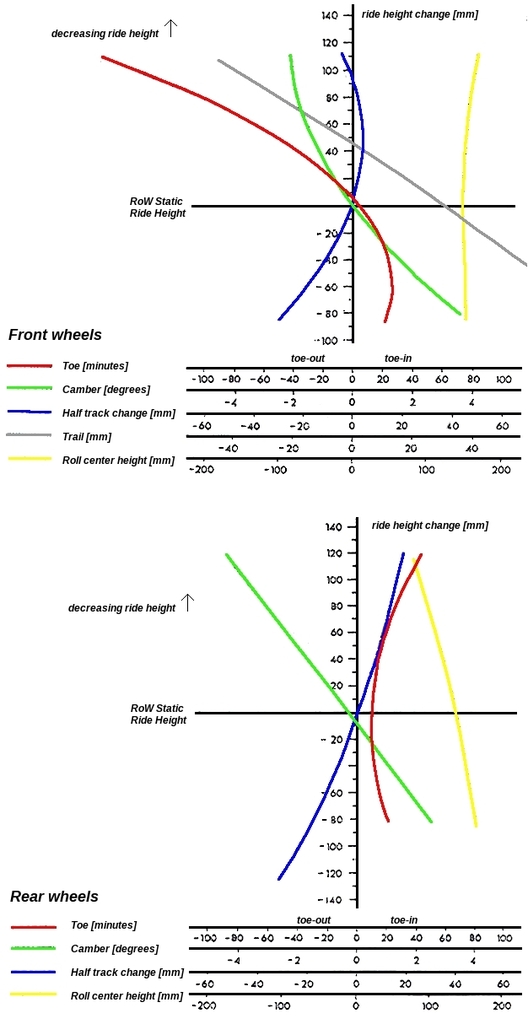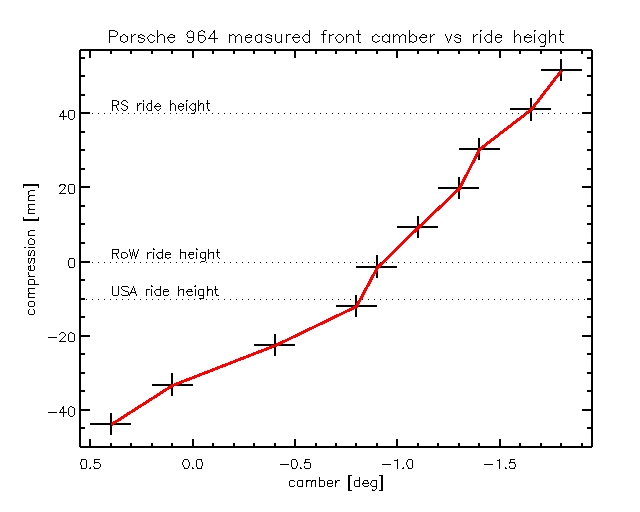suspension curves, camber, caster, toe etc.
#1
Three Wheelin'
Thread Starter
Thought that I would post these up. The first is from Bill Verburg. I don't know where he got it. His version was very hard to read, so I edited it, heavily.
The second is what I measured on mine over the weekend. It's rough, but a pretty good guide. And it agrees with Bill's curves reasonably well. Essentially, you gain about -0.1deg camber for every 10mm drop in ride height. Good to know.
I was too lazy to measure the camber vs caster curve. That would be very interesting as we all search to increase our caster.


The second is what I measured on mine over the weekend. It's rough, but a pretty good guide. And it agrees with Bill's curves reasonably well. Essentially, you gain about -0.1deg camber for every 10mm drop in ride height. Good to know.
I was too lazy to measure the camber vs caster curve. That would be very interesting as we all search to increase our caster.


The following users liked this post:
Hindsight2010 (11-12-2019)
#2
Nordschleife Master
How do you measure caster without an alignment machine? What's the ratio of camber gain versus turns on the wheel that you would use to measure caster using a wheel mounted camber gauge?
#3
Three Wheelin'
Thread Starter
Strings!  Just had it on an alignment rack last week, so I know what the current settings are as a baseline.
Just had it on an alignment rack last week, so I know what the current settings are as a baseline.
I think that camber vs steering angle at a couple caster settings would be key. It would be interesting to compare those curves to the 3.2 and GT3 cars with much more stock caster. You would need camber vs wheel angle to really compare across models, but probably not needed to get a good idea.
 Just had it on an alignment rack last week, so I know what the current settings are as a baseline.
Just had it on an alignment rack last week, so I know what the current settings are as a baseline. I think that camber vs steering angle at a couple caster settings would be key. It would be interesting to compare those curves to the 3.2 and GT3 cars with much more stock caster. You would need camber vs wheel angle to really compare across models, but probably not needed to get a good idea.
#4
Rennlist Member
Join Date: Jul 2003
Location: Peachtree City, Ga
Posts: 1,952
Likes: 0
Received 64 Likes
on
54 Posts
I have the specifics on figuring caster with a camber gauge at home. On road, will post when I get back to my garage. I did this to check my caster numbers. The basics are you turn wheel to left at an angle (22 degrees, maybe) measure camber. Then turn wheel right to same angle, measure camber.
Take and add camber angles together, then take a given percent and that is the caster. If both numbers are a negative add, if numbers are positive and negative subtract. Will send specifics when I get back
Take and add camber angles together, then take a given percent and that is the caster. If both numbers are a negative add, if numbers are positive and negative subtract. Will send specifics when I get back
#5
Rennlist Member
Join Date: Jul 2003
Location: Peachtree City, Ga
Posts: 1,952
Likes: 0
Received 64 Likes
on
54 Posts
Ok - Here is the way you can get your CASTER using a CAMBER GAUGE. First - this is right out of the SMARTCAMBER book that comes with the SMARTCAMBER gauge.
Measuring Caster-
Start with Left Front Wheel
Lay Template on floor - This is a sheet that has two 20 degree angels on it measure from a center line that is suppose to run parallel with the wheel at static position ( straight ahead) (see picture) MArk these lines on the floor.
The front wheel should be centered on the center line axis of the marks.
Turn the steering wheel until the left front wheel has turned left to the 20 degree mark. Use long ruler to verify wheel position.
Now measure camber angle. Write down number.
Now turn wheel back to center line.
Now turn the wheel to the right so that the back of the left front whell is paralle with the 20 degree angle to the rear of the center line axis. Confirm the wheel is parallel with the 20degree angle.
Measure camber angle in this positioin.
Now calculate CASTER ANGLE using one of the following methods.
1. If both angles are negative
Subtract the small from the large
i.E. (-3) - (-1) = 2
Multiple 2 X 1.5 = 3
3 Is the CASTER ANGLE of the wheel.
2. If you have a negative number and a Positive number.
ADD numbers together
(-3) + (+1) = 4
Multiply 4 x 1.5 = 6
6 degrees is the CASTER ANGLE of the wheel
3. IF both numbers are positive
Subtract small number from large
(+3) - (+1) = 2
Multiply 2 x 1.5 = 3
3 degrees is the CASTER ANGLE of the wheel.
If you can not turn your wheel to obtain an angel of 20 degrees adjust using the following figures for the multiplication factor.
20 degrees = 1.5
15 degrees = 2.0
10 degrees = 3.0
Hope this helps someone
Measuring Caster-
Start with Left Front Wheel
Lay Template on floor - This is a sheet that has two 20 degree angels on it measure from a center line that is suppose to run parallel with the wheel at static position ( straight ahead) (see picture) MArk these lines on the floor.
The front wheel should be centered on the center line axis of the marks.
Turn the steering wheel until the left front wheel has turned left to the 20 degree mark. Use long ruler to verify wheel position.
Now measure camber angle. Write down number.
Now turn wheel back to center line.
Now turn the wheel to the right so that the back of the left front whell is paralle with the 20 degree angle to the rear of the center line axis. Confirm the wheel is parallel with the 20degree angle.
Measure camber angle in this positioin.
Now calculate CASTER ANGLE using one of the following methods.
1. If both angles are negative
Subtract the small from the large
i.E. (-3) - (-1) = 2
Multiple 2 X 1.5 = 3
3 Is the CASTER ANGLE of the wheel.
2. If you have a negative number and a Positive number.
ADD numbers together
(-3) + (+1) = 4
Multiply 4 x 1.5 = 6
6 degrees is the CASTER ANGLE of the wheel
3. IF both numbers are positive
Subtract small number from large
(+3) - (+1) = 2
Multiply 2 x 1.5 = 3
3 degrees is the CASTER ANGLE of the wheel.
If you can not turn your wheel to obtain an angel of 20 degrees adjust using the following figures for the multiplication factor.
20 degrees = 1.5
15 degrees = 2.0
10 degrees = 3.0
Hope this helps someone


